Many wonderful aquatic plants that we use to brighten our planted displays aren’t always doing well in tanks with Apistogramma fish. Some need more lighting than others, and some thrive in a porous, clay-based substrate that is nutrient-rich.
In this article, we will go over the difficulties of growing live plants in Apisto tanks, a list of the best Apistogramma plants, as well as some tips and tricks for creating your best Apistogramma planted tank.
Do Apistogramma Species Eat Plants?

A large majority of Apistogramma cichlids are primarily carnivorous in their natural habitat, feeding on a variety of aquatic crustaceans and their larvae by sifting through the substrate.
In an aquarium setting, they will nibble some plant matter to pick at the microorganisms that can grow on them. Thanks to their compact size, they usually leave the larger leaves and stems untouched.
An interesting side note: The largest Apistogramma species, A. steindachneri, is the only known one that prefers a vegetarian diet.
Do Apistogramma Need Plants?
Although there are many benefits to adding live plants to an Apistogramma fish tank, it is not always necessary. In nature, most Apistogramma species live in sandy riverbeds without aquatic plants, but they are often covered with fallen leaves, driftwood, and rocks.
The Challenges of Growing Plants in Apistogramma Tanks
Understanding the most common challenges of pairing live plants with Apistogramma dwarf cichlid is essential for determining which plants are more suitable for these fish.
Lighting
The clearwater and blackwater streams from which Apistogramma originated are slow-moving waters beneath the canopy surface of dense forests with little light coming through. Plus, these fish are bottom dwellers that usually stay near the substrate.
As a result, most Apistogramma species require subdued lighting to feel comfortable and secure, which is the first hurdle when growing some plants in Apistogramma tanks.
Substrate
Another key to success with plants aquarium is using the proper substrate. Volcanic or clay-based gravel substrates work best because of their higher cation exchange capacity (CEC).
Author note: The CEC is a useful indicator of soil fertility, measuring the total number of cations such as calcium (Ca2+), magnesium (Mg2+), potassium (K+), and ammonium (NH4+) that can be held. The higher the CEC, the more nutrients the substrate can supply to the plants.Apistogramma, a proficient sand-sifter that spends much time foraging in the substrate, is better off with very fine sand to prevent its gills from being damaged.
The density of the sand makes it compact so tightly that it leads to stunted root growth and a lack of oxygen for the roots. As an inert substrate, sand comes with very few nutrients, and the addition of root tabs is necessary as fertilizer if you have rooted plants.
Using Floating Plants in Your Apistogramma Aquarium
Chances are, if you have read our other Apistogramma cichlids care guides, you know how much we love floating aquarium plants. Virtually we recommend using a thick cover of floaters in any Apistogramma tank, no matter which species!
They provide diffused lighting into the aquarium, suck up excess nutrients in the water, and give dither fish a place to hide, not to mention mimicking the natural conditions of Apistogramma and encouraging them to spawn.
As Alan DeAngelo described in the Journal of the American Cichlid Association (ACA), a covering of giant duckweed at the surface of the aquarium is a great way to make your perfect Apistogramma aquarium.
Best Floating Plants for Apistogramma
If you enjoy aquatic floating plants as much as we do, look no further than this list of our favorites.
Anacharis (Egeria densa)
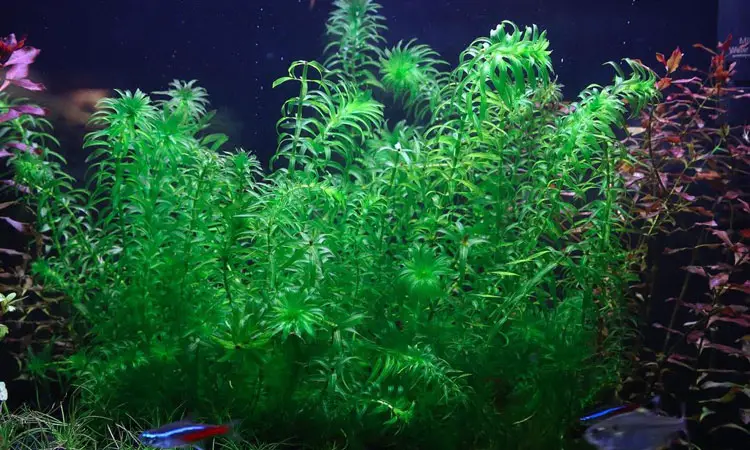
Given its rapid growth and ability to thrive in various conditions, Anacharis is considered one of the easiest floating plants to keep in the hobby. It can be kept either free floating or rooted into the substrate, depending on your personal preference.
The stem of Egeria densa can grow up to 39 inches (100 cm) and be 1.6 inches (4 cm) wide, with vivid light to bright green leaves, making it a perfect midground or background plant for different aquariums.
Do not introduce this plant to any native waterways outside of your aquarium, as it is a pain to remove.
Amazon Frogbit (Limnobium laevigatum)

Want an easy, fast-growing floating plant that will instantly provide shade and cover for your fish tank? Get the Amazon frogbit!
Also known as the West Indian Spongeplant or Smooth Frogbit, this Central and South American floating plant looks a bit like duckweed but is larger in size.
The smooth, round leaves of this species can grow up to 1.5 inches long and are a solid green color. Their long, stringy roots can reach the upper half of the water column, creating a beautiful jungle for middle-to-top level tank mates of Apistogramma to swim in and out of, such as Keyhole Cichlid, Angels, and Discus.
Butterfly Fern(Salvinia auriculata)

Native to South America, the Butterfly Fern is an interesting, floating fern that grows very fast and is easy to care for. Like Apistogramma species, it has a preference for still waters.
The light, textured leaves of Salvinia auriculata display curled edges that resemble the wings of a butterfly when viewed from above. Small hairs on the leaves can help them resist water penetration.
Cultivated as “free-floating” plants, they develop much shorter roots and do not compete with other fish for swimming space.
Dwarf Water Lettuce (Pistia stratiotes)

Dwarf Water Lettuce, or Water Cabbage, is not a real lettuce but a free-floating, fast-growing aquatic perennial commonly used as a natural ornamental plant for ponds and aquariums.
Its lettuce-shaped leaves respond well to the common name. Like Limnobium laevigatum, it has very long roots that can extend pretty deep into the water column.
Please keep in mind that this robust plant is an invasive species in the U.S. Never release it into natural water sources. It easily overpowers indigenous ecosystems and can be quite difficult to remove.
Hornwort (Ceratophyllum demersum)
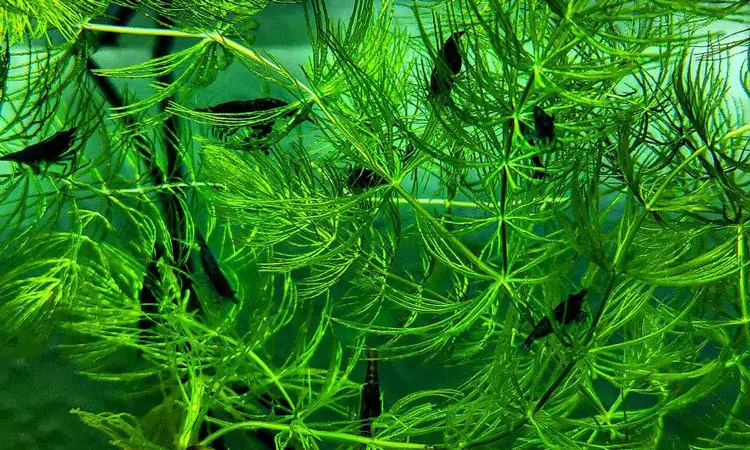
The Hornwort is another well-known plant for both aquariums and outdoor ponds because of its fast growth rate, easy care, low light requirements, and long stems with needle-like and stiff leaves.
This handy aquatic plant can tolerate a wide range of temperatures between 50-85°F (10-30°F) and can be planted in the substrate or allowed to float freely.
Top 5 Rooted Apistogramma Plants
Anubias barteri

Anubias barteri is best suited as a midground and background plant thanks to its long stems and broad, arrow-shaped leaves that can grow up to three inches long.
Similar to other Anubias species, this flowering plant thrives when its rhizome is anchored to a hard surface like driftwood or stones. It will slowly grow horizontally rather than vertically while forcing tall stems to move up toward the light.
Bolbitis heudelotii
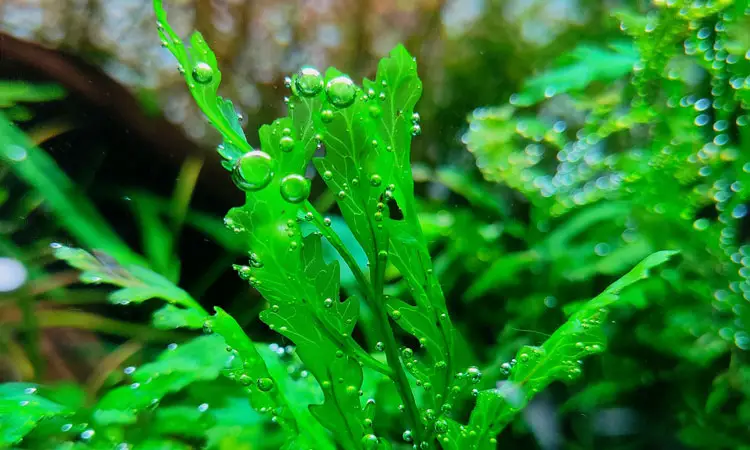
Bolbitis heudelotii, commonly known as the African Water Fern, is a mega-hardy fern that originates from Africa. It can be easily recognized by its longer, lacy-like leaves that are transparent green in color.
Bolbitis heudelotii is a gorgeous plant that can be used as a background plant in many different aquarium setups, including high-tech and low-tech tanks.
Like many ferns, this plant is epiphytic in nature and typically grows at a slower pace compared to floating plants. It can be propagated by separating the rhizomes. With enough time, light, and nutrients, it can develop into an impressive bush-like structure in your Apisto tank.
Java Fern (Microsorum pteropus)
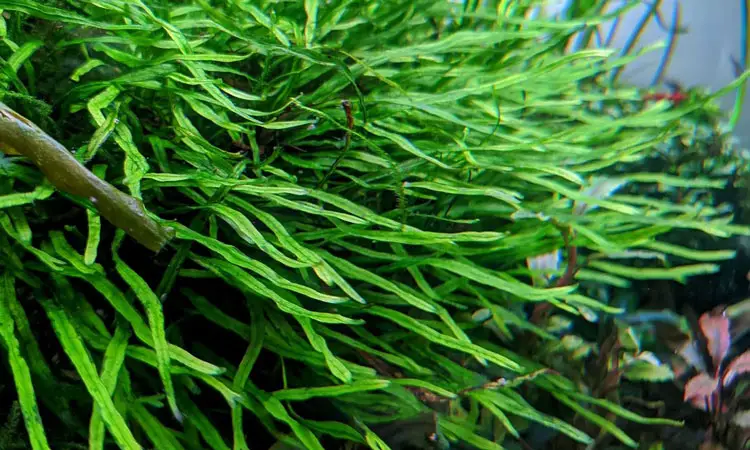
An extremely hardy plant that finds its way into many Apistogramma aquariums at one point or another. This slow-growing plant has a unique appearance with thick and wavy leaves, making it perfect for filling space.
Java ferns have plant roots that don’t require high light and planting directly into the substrate to grow in. Like Anubias barteri, attach them to the caves, wood, or other decoration using a fishing line or thread.
Many varieties are available in pet stores. Due to their slow growth and unique leaf structure, Java ferns are typically placed in the mid-ground area of the aquarium.
Java moss(Vesicularia dubyana)
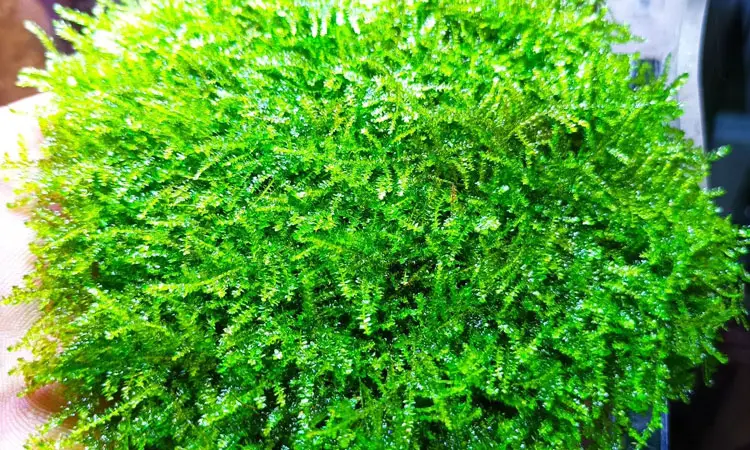
Assuming you do not mind some extra pruning work, Java Moss is an excellent choice for Apistogramma breeding tanks. This moss grows quickly and can eventually form a thick carpet on the substrate or attach itself to other decorations, giving them a natural, aged look.
Java Moss is beloved by breeders because its dense cover offers safe and comfortable living places for tiny offspring and shrimps, improving your spawn’s survival rate.
The legendary Java moss doesn’t have specific water parameters and fertilization requirements. Without actual roots, it works well in Apistogramma aquariums with sand substrate.
Cryptocoryne spp.

Cryptocoryne species (or “crypts” for short) are widely used in aquariums as mid-ground plants.
Their long, pointed leaves with a ruffled texture and different color varieties allow you to create character and depth in any aquarium.
Like Anubias, Crypts have a comparable growth rate to other plants around them – slow and steady. They can reach heights of 6-8 inches (15-20 cm) and develop a strong root network.
When keeping them in Apistogramma aquariums, the key is to make sure that you insert many root tabs into the sand to nurture their growth. Maintaining steady water parameters is also essential for these species.
Last Word
None of these “Apistogramma-proof” plants is 100% guaranteed to work in your tank. Every aquarium is different, and you should always adjust your plant selection and maintenance schedule to suit your individual needs.
If you’re still unsure about what plants to get, remember that trial and error can be an invaluable learning experience. Have fun with your Apistogramma tank, and don’t forget to check out our collection of Apistogramma articles.





